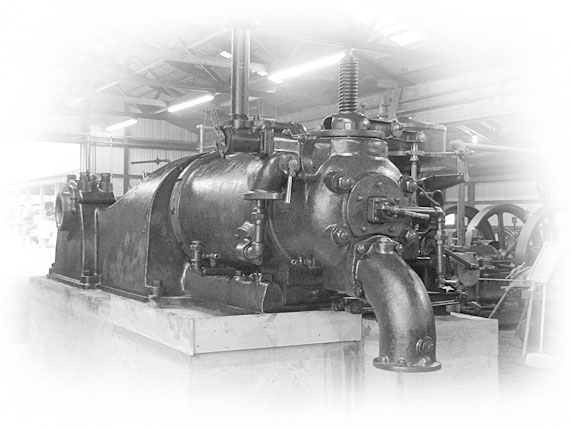#215 Coolspring Power Museum
1890-1929
Impressive variety of internal combustion engines, built primarily between 1890 and 1920 and consisting mainly of stationary engines used in industrial applications
Early internal combustion engines produced only a few horsepower and were unable to replace steam engines in most applications until about 1890. By then, they were powerful enough for most portable or remote locations and many small manufactures. By 1900, they were replacing reciprocating steam engines for electric generation, and by 1915, they were being considered for all but the largest installations where steam turbines have dominated to date. Large reciprocating steam engines were limited to those situations where instantaneous reversal was required, such as for rolling mills, locomotives, and marine service.
The Coolspring Power Museum exhibits examples of most of the early solutions and innovations that affected the marketability of the stationary internal combustion engine. There are a few that started as steam engines and were converted. The evolution of engine design is sometimes demonstrated by showing sets of engines from specific companies over time. Some are general-purpose prime movers and some are single purpose.
Built up from the collections of John Wilcox and Paul Harvey (in the 1950s), this museum grew into possibly the largest US collection of internal combustion engine technology, including about 250 engines many of which are permanently mounted and operational. Housed in 10 buildings, many pieces are now placed here on loan. Many of the engines are large enough to have been headed for destruction if not acquired by the museum. There are few duplications in the collection, from a widely diverse number of engine makers.
Among the operating engines are a 1902 Harvard-Stickney 3-hp single-cylinder farm engine (unusual, mass marketed by Sears-Roebuck), a 1895 Climax 50-hp flour-mill engine (with disc crank and pendulum governor), a 1885 Schleicher-Schumm 2-hp engine that was the American licensee of Otto and is the second oldest operating engine in the United States, two of the four known surviving Westinghouse vertical engines (dating from 1901, one of which is operational), a 1901 National Transit Klein Model 5 (John Klein's last engine, with a "masterpiece" pneumatically operated variable cutoff governor), and a 1927 Busch-Sulzer 400-hp four-cylinder vertical air-injection diesel (from the first American diesel manufacturer).
Among those on static display are a 1902 12-hp Gardner oil-field engine (the first convertible gas-to-steam engine manufactured and a 1928 Otto diesel for refrigeration that is reported to be the last engine built by Otto in Philadelphia.
The museum publishes a newsletter, Iron and Oil, and a journal, Bores and Strokes, for museum members.
Landmark Location
PO Box 19
Coolspring, PA 15730
Directions
10 miles south of I-80, Exit 13 (to Brookville, Pa.), just off Pa. State Route 36
Visiting Info
Open May-Oct, and by appointment; 814-849-6883
Related Links
Coolspring Power Museum
http://www.coolspringpowermuseum.org
Ceremony Notes
June 16, 2001
Recommended by
Marilyn reeder and Vance Packard

